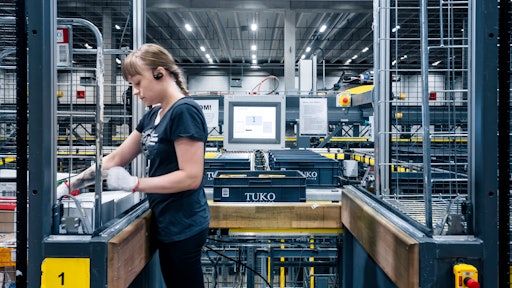
Across all industries, companies are seeing significant labor shortages in warehouses and distribution centers. These year-round shortages are felt especially hard during peak periods, when sales spike and orders flood into the warehouse. For brewers, peaks happen in the summer when people are having picnics, barbeques and beach parties, while most consumer goods companies experience sales peak during the holiday season.
Warehouse managers, supervisors and staff in facilities that rely on manual operations know the pains of trying to keep up with an influx of orders. On top of that, they have to manage expanding inventories in the same amount of space, as manufacturing raises output in response to heightened demand. Many companies hire seasonal labor to get by, but that creates additional costs and challenges like providing proper training. Consumer demand for quicker deliveries means facilities have to meet more frequent orders and get them out the door on time and with accuracy.
In reality, warehouses and distribution centers don’t have to rely solely on manual operations anymore, now they can turn to automated technology. There are four ways automation can help facilities, providing the key to not only overcoming their labor shortage problems, but also operating effectively year round and during busy peak seasons.
1. Better Utilize Your Warehouse Space
With companies producing more products in addition to seasonal goods, warehouses are quickly running out of space to store everything. Companies can look towards automated solutions that offer high-density storage to optimize space in existing facilities. These systems can often store more products while using up to 50 percent less space. Warehouses can consider floor-based storage, where goods are stacked on the warehouse floor and retrieved from above, eliminating the need for space-consuming aisles and conveyor sequencers.
2. Minimize the Number of Required Seasonal Employees
In the time leading up to a peak period, many warehouse and logistics managers attempt to double their workforce in anticipation for the flood of orders. As companies grow desperate, they end up taking practically anyone who walks through the door so there’s not enough effort placed on vetting and training seasonal staff, creating complications once orders start coming in.
With a scaleable, automated solution, distribution centers and warehouses that previously relied on temporary labor can instead use automation to get through upticks in sales and peak demand times. By design, these systems can work faster and more accurately than manual pickers with all checks and balances done through sophisticated software, virtually eliminating picking errors.
3. Improve the Roles and Responsibilities of Existing Employees
One of the biggest fears regarding automation among warehouse staff is the possible displacement of jobs. However, most facilities are running short staffed as is. With older members of the workforce beginning to retire, jobs aren’t being filled since the younger workforce seems less enthusiastic about warehousing jobs. By letting automated systems handle more products, companies can better utilize their available staff by reallocating them to handling the products that are not suitable for automation or may have special handling requirements.
Since employees are no longer responsible for picking everything, they have more time for more sophisticated tasks. It’s also safer for employees since these alternate jobs are less strenuous – particularly in facilities with heavy loads. So rather than eliminating jobs, automation makes them easier.
4. Lower labor costs
Managing an unstable workforce comes at a high cost as managers deal with high turnover rates, training costs and safety issues. The strain of hiring double the number of staff members during peak periods brings on additional expenses. In order to keep operations moving, some staff members are forced to work overtime, resulting in extra pay. Other facilities add an overnight shift, so they’re paying around the clock.
Since automation minimizes the number of seasonal staff needed, companies can save significant staffing costs. Moreover, automated systems can keep running 24/7 so employees don’t need to work as many overtime hours or night shifts. These benefits add up to major cost savings over time, enabling companies to realize a return on their investment while easily navigating busy peaks.
Once a warehouse or distribution center begins to look at automation, it must then figure out what systems to put in place and what areas within their operations would benefit the most from the technology. Fortunately, you don’t have to go it alone. Look to a provider that can assess your facility, products and processes. They will be able to tell you where it would be best to automate or stay manual – both from a cost and operational perspective. With the right combination of automation and manual handling, the labor shortage crisis will be a thing of the past, and you will be fully ready to take on any future peak period.

























